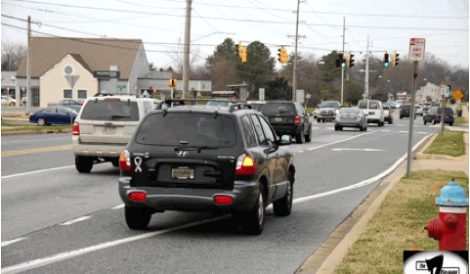White Pavement Line Markings on Delaware Roads
QUESTION: If it is WHITE then it belongs on the RIGHT — (true/false)?
Previously in this chapter it was identified that decades ago the only color of pavement line markings were WHITE. However, by now you realize that YELLOW has joined WHITE pavement line markings in identifying such driving behaviors as passing, lane changing and direction of travel.
Purpose #1 for a WHITE line is to separate lanes of traffic traveling in the same direction. The WHITE line marking can be solid, broken or even dashed, however, the main purpose is still the same – separating lanes of traffic traveling in the same direction.
Picture #13-9

In picture #13-9 above, single solid WHITE lines are separating lanes of traffic traveling in the same direction. The solid WHITE lines can be on both the left and right of traffic traveling in the same direction.
Picture #13-10

In picture #13-10 above, the broken WHITE pavement lines separate traffic traveling in the same direction. Similar to the single solid WHITE line they can be either on the left or right of your vehicle. The broken WHITE lines are painted in locations where lane changing is less hazardous than locations such as approaching a traffic light intersection.
IMPORTANT DelDOT inconsistencies: The following is a direct quote from a DelDOT letter to “The D Team” dated February 16, 2010 concerning inconsistencies in pavement line markings.
“…In the photo you enclosed, you showed two intersections on Concord Pike in New Castle County. In one photo, the road has broken white lines as the road approaches an intersection. In the other photo, there are solid white lines as the road approaches an intersection. Your letter asks why there are such inconsistencies.
According to our traffic engineers, the reason for this is that the regulations have recently changed for striping at intersections. Some intersections were painted before the regulation changed, which explains the inconsistency…”
XTRA POINT: The solid WHITE line on the right in picture #13-10 above is marking the right shoulder of the road and is not to be used as a traffic lane.
Picture #13-11

The double solid WHITE line (picture #13-11 above) is the strongest prohibitive pavement line marking. Your vehicle tires are not permitted to touch a double solid WHITE line – no turning/no lane changing!
Additionally, “The D Team” takes the position that once a single solid WHITE line begins to separate into a channeling design, it should be considered the same as a double solid WHITE line – do not touch! Picture #13-12 below is an example of channeling.
Picture #13-12

Lastly, WHITE dashed pavement line markings will be discussed – picture #13-13 below.
Picture #13-13

The dashed WHITE pavement line markings are shorter in length than broken WHITE line markings, and they are used for several different purposes.
1. Guidelines in a turn as in picture #13-13 above can be on the left, on the right and even on both the left and right depending on the number of turning lanes.
2. Preferred entry points for turn lanes as in picture #13-14 below can either be on the left or the right depending on whether you are entering a right-turn lane or a left-turn lane.
Picture #13-14

Picture #13-15

The dashed WHITE line pavement markings (picture #13-15 above) can be used to identify the lane is about to end and a merge/yield will be required. Again, the dashed WHITE line marking can either be left or right depending on which side of the road your vehicle is traveling.
REPEAT QUESTION: If it’s WHITE then it belongs on the RIGHT — (true/false)?
ANSWER: FALSE — While YELLOW pavement line markings are always left and only on rare occasions right, at the same time the WHITE pavement line markings can be left or right and even left/right at the same time.





